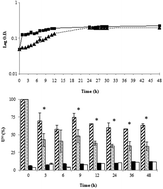Severe environmental problems arise from old uranium mines, which continue to discharge uranium (U) via acid mine drainage water, resulting in soil, subsoil and groundwater contamination. Bioremediation of U contaminated environments has been attempted, but most of the conceptual models propose U removal by cell suspensions of anaerobic bacteria. In this study, strain Rhodanobacter A2-61, isolated from Urgeiriça Mine, Portugal, was shown to resist up to 2 mM of U(VI). The conditions used (low nutrient content and pH 5) potentiated the interaction of the toxic uranyl ion with the tested strain. The strain was able to remove approximately 120 μM of U(VI) when grown aerobically in the presence of 500 μM U. Under these conditions, this strain was also able to lower the phosphate concentration in the medium and increased its capacity to take up inorganic phosphate, accumulating up to 0.52 μmol phosphate per optical density unit of the medium at 600 nm, after 24 hours, corresponding approximately to the late log phase of the bacterial culture. Microscopically dense intracellular structures with nanometer size were visible. The extent of U inside the cells was quantified by LS counting. EDS analysis of heated cells showed the presence of complexes composed of phosphate and uranium, suggesting the simultaneous precipitation of U and phosphate within the cells. XRD analysis of the cells containing the U–phosphate complexes suggested the presence of a meta-autunite-like mineral structure. SEM identified, in pyrolyzed cells, crystalline nanoparticles with shape in the tetragonal system characteristic of the meta-autunite-like mineral structures. U removal has been reported previously but mainly by cell suspensions and through release of phosphate. The innovative Rhodanobacter A2-61 can actively grow aerobically, in the presence of U, and can efficiently remove U(VI) from the environment, accumulating it in a structural form consistent with that of the mineral meta-autunite inside the cell, corresponding to effective metal immobilization. This work supports previous findings that U bioremediation could be achieved via the biomineralization of U(VI) in phosphate minerals.


 Please wait while we load your content...
Please wait while we load your content...